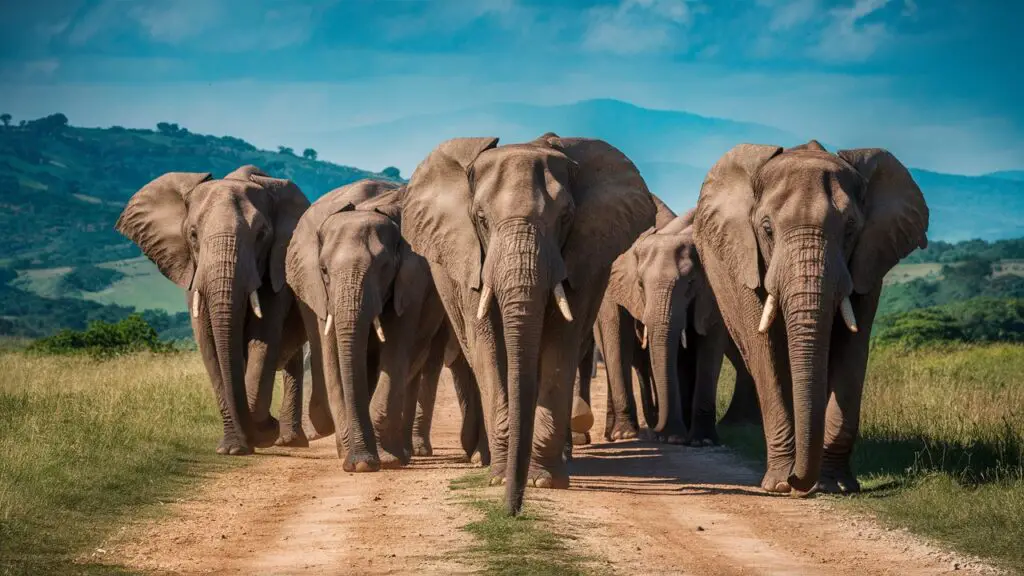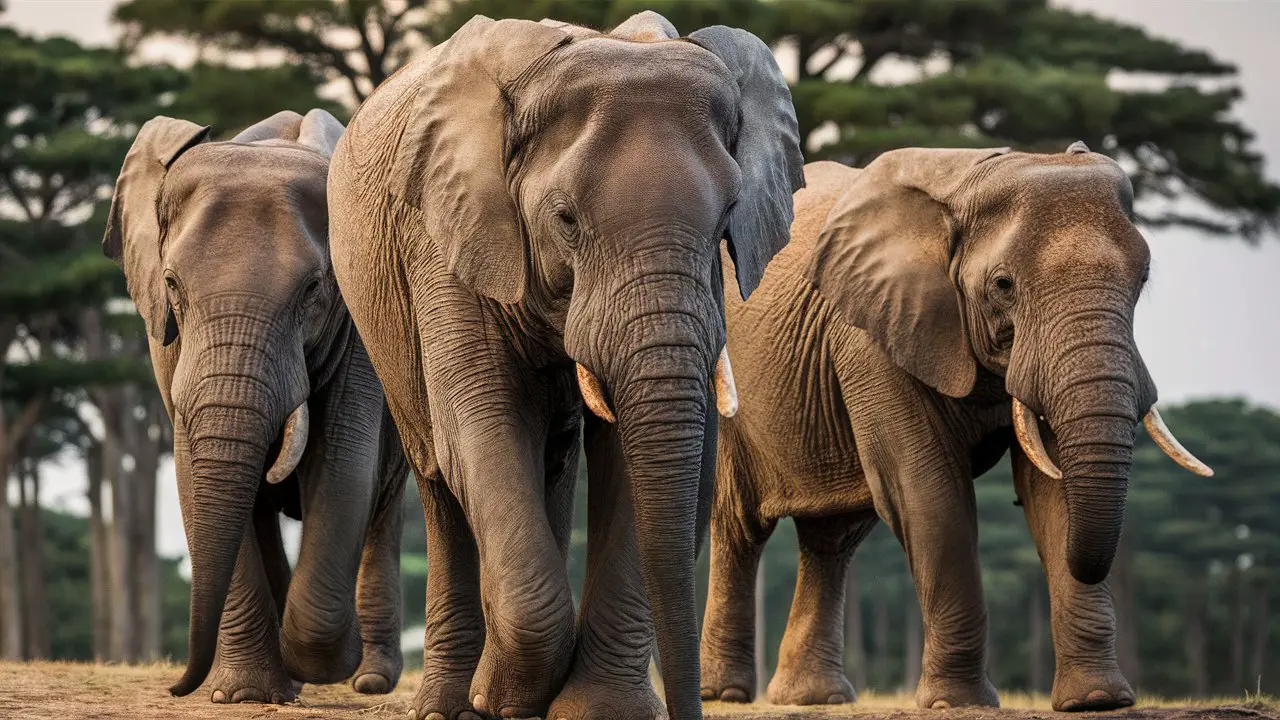You find yourself fascinated as you learn about the incredible traits that make elephants such unique animals. Their remarkable capacity for memory and advanced social behaviors intrigue you. Their complex communication methods and strong family bonds capture your interest. As you read further, the remarkable dexterity of their trunks amazes you. Their large ears and tusks adapted over time for specialized functions grab your attention. You gain appreciation for the elephants’ sheer size and presence. Throughout the article, you will uncover amazing details about the biology and behaviors of these gentle giants. The more you learn, the more enthralled you become at the distinctive qualities of these magnificent creatures.
The Incredible Size and Weight of Elephants
Elephants are the largest land animals on Earth. An adult African elephant can weigh up to 24,000 pounds and stand 13 feet tall at the shoulder. Asian elephants are slightly smaller, reaching up to 11 feet tall and 15,000 pounds.###
Their huge size is due to their evolution over millions of years. As elephants grew in size, they were better able to reach higher branches and access more abundant food sources.### Larger size also provided protection from predators. Today, an elephant’s immense size serves as an advantage for regulating body temperature and allows them to travel long distances with ease.
An elephant’s skeleton makes up only 10% of its body weight, while its muscles comprise 40-50% of its mass. Despite their huge size, elephants are graceful and agile. They can run up to 25 miles per hour for short bursts, and are excellent swimmers, using their trunks like snorkels to breathe.
An elephant’s diet requires a massive daily intake of over 300 pounds of vegetation like grass, leaves, twigs, and fruit. An adult elephant can drink up to 50 gallons of water per day. To sustain their large bodies, elephants spend three quarters of their day eating and foraging.
While an elephant’s size prompts awe and admiration, it also makes them vulnerable. Their large ivory tusks have been exploited for centuries and their habitat has declined due to human activity. Protecting these massive yet gentle giants and ensuring healthy, sustainable populations is crucial to preserving biodiversity. By respecting elephants’ immense space requirements and working to mitigate human-elephant conflict, we can help secure the future for these icons of the African and Asian wilderness.
Elephant Trunks: A Multipurpose Marvel
Elephants are fascinating creatures, in part because of their incredible trunks. An elephant’s trunk is a highly dexterous muscular organ with over 40,000 muscles. It serves various purposes, including breathing, grasping objects, smelling, touching, and making sounds.
Extreme Dexterity and Strength
Elephant trunks have an amazing range of motion and dexterity. They can pick up objects as small as a coin or as large as a tree trunk. Elephants use their trunks to grasp food, rip leaves from trees, and move obstacles from their path. The trunk’s dexterity and strength are unmatched in the animal kingdom.
A Sensitive Organ
An elephant’s trunk also has a keen sense of smell and touch. It contains many nerve endings and smell receptors, allowing elephants to sense smells and touch subtle textures. They use their trunks to smell food, locate water sources, and identify other elephants. The sensitive trunk tip can grasp items with a firm yet gentle touch.
A Built-In Snorkel
One of the most important functions of an elephant’s trunk is breathing. An elephant’s trunk contains two nostrils at the end that can close individually or together. When the nostrils are closed, the trunk acts as a snorkel, allowing the elephant to breathe while mostly submerged in water. The trunk’s complex respiratory system and musculature give elephants a high level of control over their breathing.
In summary, the elephant trunk is a biological marvel that serves various critical functions. From grasping objects to sniffing scents to manipulating their environment, elephant trunks demonstrate an astonishing combination of strength, dexterity, and sensitivity. They are a key part of what makes elephants such intelligent and fascinating social animals.
The Matriarchal Society of Elephant Herds
Elephant herds demonstrate a matriarchal social structure where the oldest female, the matriarch, leads the herd. As the matriarch ages and becomes less fertile, her daughters and granddaughters will take over leadership roles. This matriarchal system provides stability and knowledge to the herd.
Guidance and Knowledge
The matriarch holds an immense amount of knowledge about the herd’s home range, available resources, and potential dangers. She guides the herd to abundant food and water sources during dry seasons and leads them to safety during times of danger. The matriarch’s age and experience are invaluable to the herd’s survival.
Younger females stay with the herd their entire lives, learning from the matriarch and observing her leadership. When the matriarch passes away, the next oldest and most experienced female will take her place to ensure continuity of knowledge and guidance for the herd.
A Strong Bond
There are strong family bonds within elephant herds. The matriarch is typically the herd’s oldest female and leads her own daughters, granddaughters and great-granddaughters. Although males leave the herd once they reach sexual maturity, females remain with their natal herd for life.
The matriarch shows a high level of care and empathy towards the other herd members. If a herd member falls ill or becomes injured, the matriarch will stay by their side to protect and comfort them. The bond between the matriarch and her herd is powerful and lifelong.
In conclusion, elephant herds demonstrate a strong matriarchal social structure where the oldest and most experienced female leads with care, knowledge and empathy. The matriarch guides her herd to food and protects them from danger, forging lifelong bonds between mothers, daughters and granddaughters. Her age and experience are essential to the herd’s survival and prosperity. The matriarchal system of elephant herds highlights the importance of female social connections and knowledge in the animal kingdom.

African Elephant Habitat and Migration Patterns
African elephants inhabit a variety of habitats in sub-Saharan Africa, ranging from savannas to dense forests. Their migration patterns are complex and often dictated by the availability of food and water resources in their environment.
Savanna Grasslands
Savanna grasslands with scattered shrubs and trees make up the majority of the African elephant’s habitat. These open woodlands provide ample space for elephant herds to roam while also offering shelter and food sources. Elephants feed on grasses, leaves, and bark in these areas. During the dry season, elephant herds living in savannas will migrate to areas where surface water and vegetation are more plentiful.
Tropical Rainforests
Some elephant populations dwell in tropical rainforests, such as in central and western Africa. These dense forests provide shade and shelter for elephants but make long-distance migration difficult. Elephants in rainforests feed on a variety of trees, shrubs and fruits. They create paths and clearings in the thick vegetation as they traverse their home range.
Deserts and Mountains
In certain regions of Africa, elephants migrate from lowland areas into mountainous and desert habitats. For example, some elephant herds in Namibia follow ancient migration routes from coastal plains into the Namib Desert and Damaraland’s mountains. These challenging environments provide scarce but critical resources during dry periods. Elephants dig for underground aquifers in deserts and feed on desert shrubs and scrubs. In the mountains, they feed on bush grasses and shrubs.
The migration patterns and choice of habitat for African elephant herds depend on several factors, including availability of food and water, climate and seasonal changes, as well as human activity in the region. By utilizing diverse habitats and following ancestral migration routes, elephant populations have adapted well to the ebbs and flows of their environment in order to survive and thrive. Protecting connected habitats and migration corridors is critical to the long term conservation of these iconic animals.
More Interesting Facts About Elephants: FAQ
How much do elephants eat in a day?
On average, an adult elephant can eat up to 300-600 pounds of food per day. Elephants require a large amount of food to meet their nutritional needs due to their immense size. Their diet primarily consists of grasses, small plants, leaves, and bark. Elephants spend up to 16 hours a day feeding and foraging to consume the necessary amount of food required for their large bodies.
How much do elephants sleep?
Elephants only sleep 3 to 7 hours per day on average. They sleep standing up or leaning against something, but only sleep lying down for short periods. Elephants are polyphasic sleepers, meaning they sleep for short periods throughout the day and night. Their short sleep requirements could be an evolutionary adaptation to avoid predators and allow more time for feeding.
How fast can elephants run?
Elephants can reach speeds up to 25 miles per hour. Despite their large size, elephants are capable of short bursts of speed. However, they cannot maintain this speed for long due to their immense body size. Their highest speed is limited by their bone structure. Elephants use their speed as a defense mechanism to charge at predators or intruders. Their speed, combined with their large size, makes them a formidable force.
How long do elephants live?
Elephants are long-living animals, with life expectancies of 60-70 years in the wild. Some captive elephants have been known to live into their 80s. A female elephant is called a cow, and males are called bulls. Female elephants typically give birth to one calf after a 22-month pregnancy. Elephant calves are cared for by their mothers and other females in the herd for up to 10 years. Due to their advanced social behaviors and long life spans, elephants are highly intelligent and empathetic animals.
Don’t Miss a Thing! Enhance Your Wildlife Photography with Ultra-X Night Vision Goggles.
GET NOW!

Conclusion
As we have explored, elephants possess many amazing and unique traits. From their incredible memories, complex social structures, advanced communication abilities, and impressive size and strength, elephants continue to astound us. While threats like poaching and habitat loss remain, a greater understanding and appreciation for these majestic creatures can help ensure their continued survival. By supporting conservation efforts and respecting elephants in the wild, we all have a role to play in preserving them for future generations. Though there is still much to uncover about their incredible lives, it is clear that elephants have captivated humans across centuries and cultures – and will continue to do so as long as we protect them.





